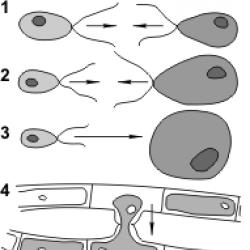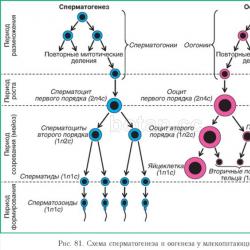Asexual and sexual reproduction in plants. Reproduction: asexual and sexual Which animals reproduce sexually and asexually
Question 1. Compare the evolutionary significance of asexual and sexual reproduction.
Asexual reproduction is an ancient form of self-reproduction, characteristic of organisms of all kingdoms of living nature. Such reproduction ensures the process of self-reproduction of a large number of identical organisms without the participation of germ cells, which is carried out by only one parent. The main property of asexual reproduction is the exact reproduction of the hereditary properties of the parent. Asexual reproduction is also more advantageous under relatively constant conditions.
Sexual reproduction is carried out with the participation of germ cells from two parent organisms - female and male, which transmit the characteristics of their hereditary material to the new organism. The main feature (condition) of sexual reproduction is fertilization, i.e. the fusion of female and male reproductive cells (gametes) and the formation of one cell - a zygote. It contains hereditary information from both parents. Each daughter individual developing from a zygote carries the properties of two different organisms of the same species. Therefore, during sexual reproduction, something new always appears in a new organism, something that has not yet been found in nature, although it is very similar to both its parents. Such organisms with new hereditary properties received from both parents often turn out to be more adapted to life in changing environmental conditions. Consequently, the biological significance of sexual reproduction lies not only in the self-reproduction of individuals, but also in ensuring the biological diversity of species, their adaptive capabilities and evolutionary prospects. This makes sexual reproduction biologically more progressive than asexual reproduction.
Question 2. Describe the role of secondary sexual characteristics in the reproduction of organisms.
Secondary sexual characteristics develop under the influence of sex hormones, indicating the sexual maturity of the individual. They are manifested in differences in the size and proportions of the body, plumage color, in the features of hair, emitted sound signals (in birds), the presence of a gestating bursa, mammary glands, etc. In some species these signs are constant, in others they may appear only during the mating season .
The main role of secondary sexual characteristics is to ensure attractiveness in the eyes of the opposite sex. Of course, many secondary signs do not play any role in reproduction and are only a consequence of age-related changes in the body, for example, an Adam's apple in men, a deepening of the voice, and features of the hairline. But if you look deeper, they all contribute to giving a person masculinity or femininity, which in turn also ensures attractiveness. In the animal world, secondary sexual characteristics play an even greater role; just remember the pride of the rooster - the comb, the horns of the elk, the coloring of many males and females. All this is necessary to attract the opposite sex and create a more “worthy” couple for procreation.
Question 3. Explain the role of the organism (individual) in the evolution of the organic world, the unit of which is considered to be the population.
Each organism (individual) carries within itself a piece of the gene pool (its own genotype) of the population. With each new crossing, the individual receives a completely new genotype. This is a uniquely important role of organisms that carry out the process of constant renewal of hereditary properties in new generations thanks to sexual reproduction. One individual cannot evolve; it gives a “impetus” to an entire population. It can change, adapting to environmental conditions, but these are non-heritable traits. Organisms, like no other form of living matter, are able to sense the external world, the state of their body and respond to these sensations, purposefully changing their actions in response to irritation coming from external and internal factors. Organisms can learn and communicate with individuals of their own species, build homes and create conditions for raising young, and show parental care for their offspring.
Abstract: Asexual and sexual reproduction
Introduction
The ability to reproduce, that is, to produce a new generation of individuals of the same species, is one of the main characteristics of living organisms. During the process of reproduction, genetic material is transferred from the parent generation to the next generation, which ensures the reproduction of characteristics not only of a given species, but of specific parent individuals. For a species, the meaning of reproduction is to replace those of its representatives who die, which ensures the continuity of the existence of the species; in addition, under suitable conditions, reproduction makes it possible to increase the total number of the species.
Each new individual, before reaching the stage at which it is capable of reproduction, must go through a number of stages of growth and development. Some individuals die before reaching the reproductive stage (or sexual maturity) as a result of destruction by predators, diseases and various random events; therefore, the species can survive only on the condition that each generation produces more offspring than there were parent individuals who took part in reproduction. Population sizes fluctuate depending on the balance between reproduction and extinction of individuals. There are a number of different propagation strategies, each with distinct advantages and disadvantages; all of them will be described in this abstract.
And the purpose of my work is to consider some types of reproduction.
Asexual and sexual reproduction
There are two main types of reproduction - asexual and sexual. Asexual reproduction occurs without the formation of gametes and involves only one organism. Asexual reproduction usually produces identical offspring, and the only source of genetic variation is random mutations.
Genetic variability is beneficial to the species, since it supplies “raw materials” for natural selection, and therefore for evolution. The offspring that are most adapted to their environment will have an advantage in competition with other members of the same species and will have a greater chance of surviving and passing on their genes to the next generation. Thanks to this, species are able to change, i.e., the process of speciation is possible. Increased variation can be achieved by mixing the genes of two different individuals, a process called genetic recombination, which is an important feature of sexual reproduction; In a primitive form, genetic recombination is already found in some bacteria.
Asexual reproduction
In asexual reproduction, offspring come from one organism, without the fusion of gametes. Meiosis is not involved in the process of asexual reproduction (unless we talk about plant organisms with alternating generations), and the descendants are identical to the parent individual. Identical offspring descended from the same parent are called clones. Members of the same clone can be genetically different only if a random mutation occurs. Higher animals are not capable of asexual reproduction, but several successful attempts have recently been made to clone some species artificially; we will look at them later.
Division
Spore formation (sporulation)
A spore is a single-celled reproductive unit, usually microscopic in size, consisting of a small amount of cytoplasm and a nucleus. The formation of spores is observed in bacteria, protozoa, representatives of all groups of green plants and all groups of fungi. Spores can vary in type and function and are often formed in special structures.
Often, spores are formed in large quantities and have negligible weight, which makes them easier to spread by wind, as well as by animals, mainly insects. Due to their small size, the spore usually contains only minimal nutrient reserves; Because many spores do not reach a suitable location for germination, spore losses are very high. The main advantage of such spores is the ability to quickly reproduce and spread species, especially fungi.
Bacterial spores, strictly speaking, do not serve for reproduction, but to survive under unfavorable conditions, since each bacterium produces only one spore. Bacterial spores are among the most resistant: for example, they can often withstand treatment with strong disinfectants and boiling in water.
Budding
Budding is one of the forms of asexual reproduction, in which a new individual is formed in the form of an outgrowth (bud) on the body of the parent individual, and then separates from it, turning into an independent organism, completely identical to the parent. Budding occurs in different groups of organisms, especially in coelenterates such as Hydra (Fig. 1) and in single-celled fungi such as yeast. In the latter case, budding differs from fission (which is also observed in yeast) in that the two resulting parts have different sizes.
An unusual form of budding is described in the succulent plant bryophyllum, a xerophyte often grown as an ornamental houseplant: miniature plants equipped with small roots develop along the edges of its leaves (Fig. 2); these “buds” eventually fall off and begin to exist as independent plants.
Reproduction by fragments (fragmentation)
Fragmentation is the division of an individual into two or more parts, each of which grows and forms a new individual. Fragmentation occurs, for example, in filamentous algae such as Spirogyra. The spirogyra thread can break into two parts anywhere.
Fragmentation is also observed in some lower animals, which, unlike more highly organized forms, retain a significant ability to regenerate from relatively poorly differentiated cells. For example, the body of nemerteans (a group of primitive worms, mainly marine) is especially easily torn into many parts, each of which can give rise to a new individual as a result of regeneration. In this case, regeneration is a normal and regulated process; however, in some animals (for example, starfish), restoration from individual parts occurs only after accidental fragmentation. Animals capable of regeneration serve as objects for experimental study of this process; Often a free-living planarian worm is used. Such experiments help to understand the differentiation process.
Vegetative propagation
Vegetative propagation is a form of asexual propagation in which a relatively large, usually differentiated part is separated from the plant and develops into an independent plant. Essentially, vegetative propagation is similar to budding. Often, plants form structures specifically designed for this purpose: bulbs, corms, rhizomes, stolons and tubers. Some of these structures also serve to store nutrients, allowing the plant to survive periods of unfavorable conditions such as cold or drought. Storage organs allow the plant to survive the winter and produce flowers and fruits the following year (biennial plants) or survive for a number of years (perennial plants). These organs, called overwintering organs, include bulbs, corms, rhizomes and tubers.
Overwintering organs can also be stems, roots or entire shoots (buds), but in all cases the nutrients they contain are created mainly during the process of photosynthesis occurring in the leaves of the current year. The resulting nutrients are transferred to the storage organ and are then usually converted into some insoluble storage material, such as starch. When unfavorable conditions occur, the above-ground parts of the plant die, and the underground hibernating organ goes into a dormant state. At the beginning of the next growing season, nutrient reserves are mobilized with the help of enzymes: the buds awaken, and the processes of active growth and development begin in them due to the stored nutrients. If more than one bud sprouts, then we can assume that reproduction has occurred.
In some cases, special organs are formed that serve for vegetative propagation. These are the modified parts of the stem - potato tubers, onion bulbs, garlic bulbs, bulblets in the leaf axils of the bluegrass, shoots of the young, etc. Strawberries reproduce with “mustaches” (Fig. 3). Adventitious roots are formed at the nodes of the shoots, and shoots with leaves are formed from the axillary buds. Subsequently, the internodes die off, and the new plant loses its connection with the mother plant.
Reproduction- the ability of living organisms to reproduce their own kind. There are two main reproduction method- asexual and sexual.
Asexual reproduction occurs with the participation of only one parent and occurs without the formation of gametes. The daughter generation in some species arises from one or a group of cells of the mother’s body, in other species - in specialized organs. The following are distinguished: methods of asexual reproduction: division, budding, fragmentation, polyembryony, sporulation, vegetative propagation.
Division- a method of asexual reproduction characteristic of unicellular organisms, in which the mother is divided into two or more daughter cells. We can distinguish: a) simple binary fission (prokaryotes), b) mitotic binary fission (protozoa, unicellular algae), c) multiple fission, or schizogony (malarial plasmodium, trypanosomes). During the division of the paramecium (1), the micronucleus is divided by mitosis, the macronucleus by amitosis. During schizogony (2), the nucleus is first divided repeatedly by mitosis, then each of the daughter nuclei is surrounded by cytoplasm, and several independent organisms are formed.
Budding- a method of asexual reproduction in which new individuals are formed in the form of outgrowths on the body of the parent individual (3). Daughter individuals can separate from the mother and move on to an independent lifestyle (hydra, yeast), or they can remain attached to it, in this case forming colonies (coral polyps).
Fragmentation(4) - a method of asexual reproduction, in which new individuals are formed from fragments (parts) into which the maternal individual breaks up (anneli, starfish, spirogyra, elodea). Fragmentation is based on the ability of organisms to regenerate.
Polyembryony- a method of asexual reproduction in which new individuals are formed from fragments (parts) into which the embryo breaks up (monozygotic twins).
Vegetative propagation- a method of asexual reproduction in which new individuals are formed either from parts of the vegetative body of the mother individual, or from special structures (rhizome, tuber, etc.) specifically designed for this form of reproduction. Vegetative propagation is typical for many groups of plants and is used in gardening, vegetable gardening, and plant breeding (artificial vegetative propagation).
| Vegetative organ | Method of vegetative propagation | Examples |
|---|---|---|
| Root | Root cuttings | Rosehip, raspberry, aspen, willow, dandelion |
| Root suckers | Cherry, plum, sow thistle, thistle, lilac | |
| Aboveground parts of shoots | Dividing bushes | Phlox, daisy, primrose, rhubarb |
| Stem cuttings | Grapes, currants, gooseberries | |
| Layerings | Gooseberries, grapes, bird cherry | |
| Underground parts of shoots | Rhizome | Asparagus, bamboo, iris, lily of the valley |
| Tuber | Potatoes, sunflower, Jerusalem artichoke | |
| Bulb | Onion, garlic, tulip, hyacinth | |
| Corm | Gladiolus, crocus | |
| Sheet | Leaf cuttings | Begonia, gloxinia, coleus |
Sporulation(6) - reproduction through spores. Controversy- specialized cells, in most species they are formed in special organs - sporangia. In higher plants, spore formation is preceded by meiosis.
Cloning- a set of methods used by humans to obtain genetically identical copies of cells or individuals. Clone- a collection of cells or individuals descended from a common ancestor through asexual reproduction. The basis for obtaining a clone is mitosis (in bacteria - simple division).

Sexual reproduction is carried out with the participation of two parent individuals (male and female), in which specialized cells are formed in special organs - gametes. The process of gamete formation is called gametogenesis, the main stage of gametogenesis is meiosis. The daughter generation develops from zygotes- a cell formed as a result of the fusion of male and female gametes. The process of fusion of male and female gametes is called fertilization. An obligatory consequence of sexual reproduction is the recombination of genetic material in the daughter generation.
Depending on the structural features of the gametes, the following can be distinguished: forms of sexual reproduction: isogamy, heterogamy and oogamy.
Isogamy(1) - a form of sexual reproduction in which gametes (conditionally female and conditionally male) are mobile and have the same morphology and size.
Heterogamy(2) - a form of sexual reproduction in which female and male gametes are motile, but female gametes are larger than male ones and less mobile.
Oogamy(3) - a form of sexual reproduction in which female gametes are immobile and larger than male gametes. In this case, female gametes are called eggs, male gametes, if they have flagella, - spermatozoa, if they don’t have it, - sperm.
Oogamy is characteristic of most species of animals and plants. Isogamy and heterogamy occur in some primitive organisms (algae). In addition to the above, some algae and fungi have forms of reproduction in which sex cells are not formed: hologamy and conjugation. At hologamia single-celled haploid organisms merge with each other, which in this case act as gametes. The resulting diploid zygote then divides by meiosis to produce four haploid organisms. At conjugation(4) the contents of individual haploid cells of filamentous thalli merge. Through specially formed channels, the contents of one cell flow into another, a diploid zygote is formed, which usually, after a period of rest, also divides by meiosis.
Go to lectures No. 13“Methods of division of eukaryotic cells: mitosis, meiosis, amitosis”
Go to lectures No. 15"Sexual reproduction in angiosperms"
Reproduction is a method of reproduction of generations inherent in all living organisms, regardless of the complexity of the organization. There is sexual and asexual reproduction of organisms. These two processes are significantly different from each other.
Asexual
Reproduction is considered asexual if gametes - sex cells - do not participate in the formation of a new organism. The resulting individual is practically indistinguishable from the parent organism.
There are several methods of asexual reproduction:
- division - the formation of several daughter individuals from the parent’s body, characteristic of unicellular organisms;
- sporulation or sporulation - reproduction by special cells (spores), characteristic of fungi and plants;
- fragmentation or strobilation - the formation of descendants from parts or segments of the parent individual, characteristic of algae, multicellular animals (coelenterates, worms);
- budding - the emergence of a new individual from the outgrowth of the parent organism, characteristic of some types of fungi, mosses, as well as coelenterates, sponges, worms;
- vegetative propagation - reproduction with the help of vegetative organs (roots, leaves, stems, modified shoots), characteristic of plants.

Rice. 1. Strobilation in jellyfish at the polyp stage.
Sexual
During sexual reproduction, genetic material is exchanged between two individuals, and the formation of a new organism occurs through the fusion of gametes. The table shows the types of sexual reproduction.
|
Way |
Description |
Example |
|
Conjugation |
Fertilization through mutual exchange of genetic information. Nuclear exchange occurs via a cytoplasmic bridge |
Ciliates, Spirogyra |
|
Hermaphroditism |
The presence of sexual characteristics (gametes) in one individual. A parent can simultaneously perform the functions of father and mother or, when meeting another representative of the species, perform the function of one of the partners (female or male) |
Grape snails, flatworms, sea bass |
|
Parthenogenesis |
“Virgin reproduction” - the development of a new individual from the mother’s egg without the participation of a male |
Bees, some species of lizards, daphnia, aphids |
|
Copulation (gametogamy) |
The process of fusion of gametes and the formation of a mononuclear zygote. There are three types: Isogamy - participation in the sexual process of identical gametes with flagella (ulotrix, chlamydomonas); Anisogamy - the zygote is formed by motile gametes of different sizes (mosses, green algae); Oogamy - two different cells merge: one large, immobile (egg), the other small and mobile (sperm) |
Algae, most vertebrate and invertebrate animals and flowering plants |

Rice. 2. Comparison of germ cells in isogamy, anisogamy, oogamy.
Sexual and asexual reproduction of plants is typical for many representatives of the angiosperm division, as well as for algae. Flowering plants can reproduce by vegetative organs and seeds. For example, a new raspberry bush can grow from a seed and from a cutting from a parent plant. Chlamydomonas divides under favorable conditions and forms gametes under unfavorable conditions.

Rice. 3. Methods of reproduction of Chlamydomonas.
Comparison
The main difference between asexual and sexual reproduction is cells. To obtain a new individual sexually, gametes are needed, and asexually, somatic cells are needed.
A comparison of sexual and asexual reproduction is given in the table.
Meaning
In addition to its biological significance (reproduction of individuals), reproduction has an evolutionary significance associated with genotype and variability. Hereditary traits are passed on from generation to generation. Moreover, during ontogenesis - individual development - each individual, regardless of the method of reproduction, acquires personal traits that are not characteristic of its parents.
TOP 2 articleswho are reading along with this
Variability is the main condition of natural selection, as a result of which new species more adapted to environmental conditions appear.
Sexual reproduction has an advantage over asexual reproduction in the form of recombination. This is the process of redistribution of parental genes that occurs during meiosis. As a result, descendants receive a new combination of genes. Recombination is the basis of variability and a method of survival of a species. Rarely occurs in somatic cells, i.e. with asexual reproduction.
What have we learned?
From the 9th grade lesson we learned about the features, methods and significance of asexual and sexual reproduction. During asexual reproduction, exact reproduction of the parent occurs. Sexual reproduction involves two individuals, providing the offspring with new combinations of genes that help adapt to changing conditions.
Test on the topic
Evaluation of the report
Average rating: 4.7. Total ratings received: 254.





